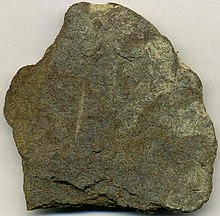
Tasmanite is a sedimentary rock type almost entirely consisting of the prasinophyte alga Tasmanites. It is commonly associated with high-latitude, nutrient-rich, marginal marine settings found in Tasmania. It is classified as marine type oil shale. It is found in many oil-prone source rocks and, when present, contributes to the oil generation potential of the rock. Some sources also produce a red-brown translucent material similar to amber which has also been called tasmanite.
In 1865, Professor A. J. Church, near the floodplain of the Mersey River (Northern Tasmania), found translucent reddish-brown or brown samples of an unknown mineral resembling amber embedded in shale in one of the small Tasmanite deposits. These differences ultimately amounted to up to 40% of the main rock and had the appearance of narrow, scaly lenses, difficult to separate from the main rock. Professor Church carried out laboratory chemical analysis and made a detailed description of the new mineral, naming it by the same name as the parent rock: Tasmanite. Later, the trivial name “Tasmanian amber” was assigned to it.
See also
- Tasmanian amber
- List of minerals named Tasmanite
- Cannel coal
- Kukersite
- Lamosite
- Marinite
- Torbanite
- Oil shale geology
- List of shale oil operations in Australia (Tasmania)
References
- Peters, K.E., C.C. Walters & P.J. Mankiewicz, 2006, Evaluation of kinetic uncertainty in numerical models of petroleum generation, American Association of Petroleum Geologists Bulletin, 90, 387–403.
- Hutton, A.C. 1987. Petrographic classification of oil shales // Intern. J. Coal Geol. 1987. Vol. 8. P. 203–231.
- Сhurch N. J., The latest research into the landscape of Northern Tasmania and its natural minerals. — 1865, р. 480.
This article is a stub. You can help Misplaced Pages by expanding it. |